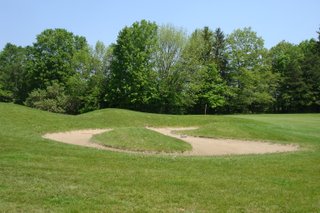What Beyond the Scenery Made Pacific Dunes Great?

The second of the back to back par threes, the wonderful short 11th
There is no question the setting is unparalleled. The beautiful sand dunes and jaw dropping views up and down the coast make Pacific Dunes one of the most beautiful locations in golf. It bears a striking resemblance to the holes east of 17 Mile Drive at Cypress Point. It was undoubtedly one of the great sites to be given to any architect in recent memory. As Bill Coore said, “He was the right architect on the right site at the right time in his career”. He went on to suggest that he could not do a better job and since Bill Coore is the top architect in golf, this would be the ultimate compliment.
But it’s not just the site that makes the course great. The architecture is very provocative, and many of Tom’s decisions took courage to go against convention. While I really like Bandon Dunes, there is no question in my mind that Pacific Dunes is a superior golf course on an equal site. So why is that?
Well the best thing to do is give you a list of the unconventional ideas he used to make the course great. Number one is he designed a modest length golf course that would be called short by modern standards. Why would he do this you ask? Because that was what the best routing the site would yield according to Doak. He also pointed out that Bandon Dunes was plenty long so building a shorter course was not a big issue. So big deal it’s a little short. Well what this allowed Doak to do was build more short and interesting par fours than most modern courses. There are a couple of real classics in the 6th and 16th.
Looking down the coastline, over the blow out bunkers, on the spectacular 13th
Now I mentioned the routing, and that was where Tom took the largest risk and opened himself up to criticism by designing an unconventional distribution of holes. He used back to back par threes to open the back nine. They fit perfectly and placed two dramatic holes looking out and then along the ocean. These are two very memorable holes to play. He ended up with a routing on the back nine that had two (yes two!) par fours, since that was the best routing for the holes. Imagine a course with one three and one five on the front; then four threes, two fours and three fives on the back. Yet it was the right thing to do.
The final ideas are the details of the course. Tom also used alternate greens on the ninth and alternate tees on the tenth rather than choosing between two equally good options on the holes. Rather than bunkers he has blow outs that fit beautifully into the natural dune areas. He created very wide fairways for playability in high winds and then bunkered inside the fairway lines to preserve the width while providing some strategic challenge to each of the holes. He built wonderfully rolling greens that flow naturally out into the fairway of chipping areas so naturally that you don’t notice the transitions.
Finally Tom never worried about people finding the course not challenging enough and concentrated on making it the most beautiful and interesting place you may ever play. Playing it makes me think of my round at Cypress Point. What architect wouldn’t like that comparison?







